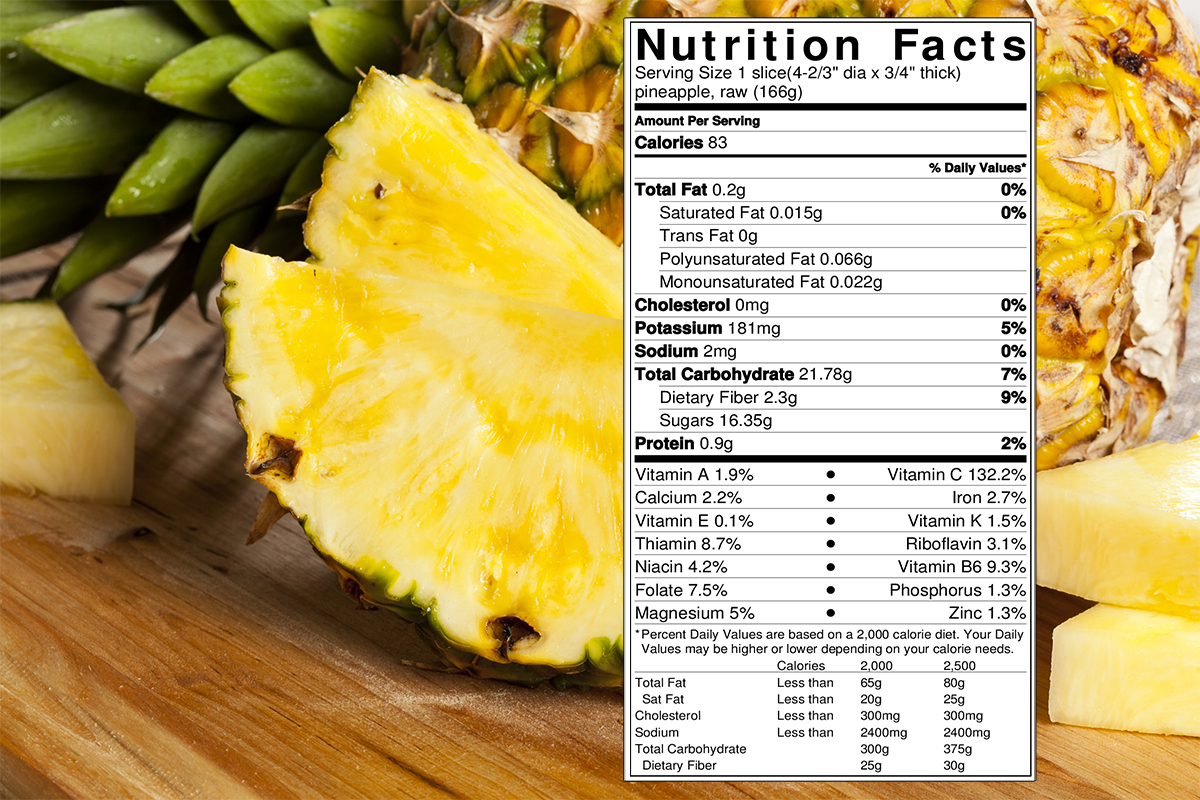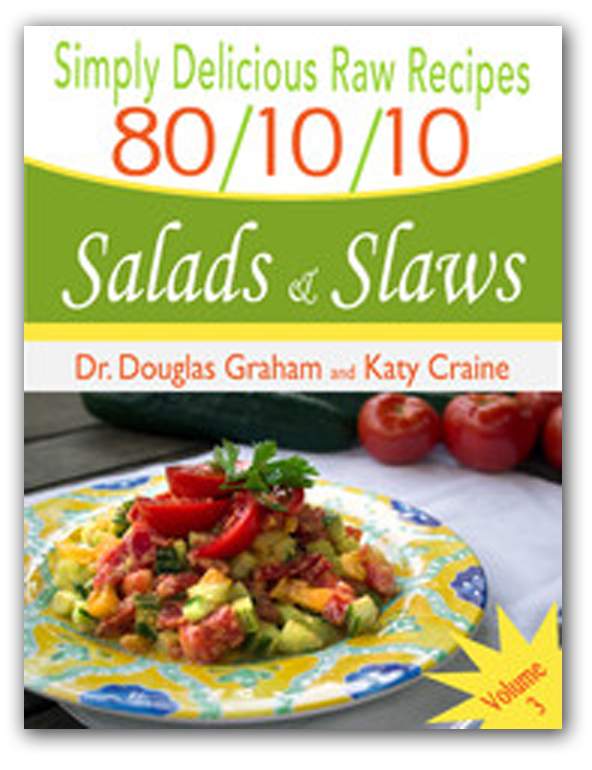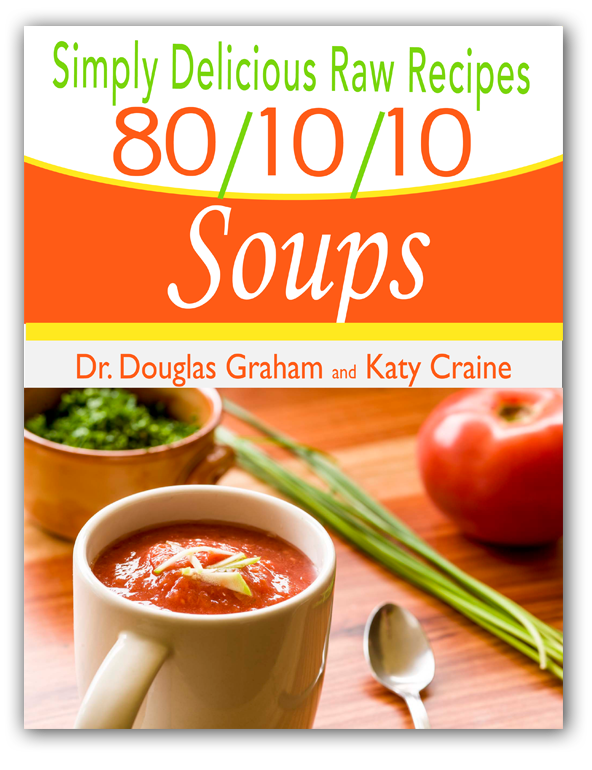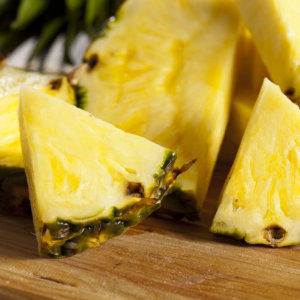
One 4-2/3″ diameter x 3/4″ thick slice of raw pineapple contains 83 calories.
94% carbs, 2% fat, 4% protein
A golden slice of pineapple can shine some tropical sun on even the coldest winter day. It’s no wonder that after bananas, pineapples are the world’s most popular fruit. But choosing a good, sweet pineapple can be a challenge – what’s the secret? We’ll tell you.
Brief History of Pineapples
The native people of Brazil and Paraguay who first cultivated it called “anana,” or “excellent fruit”. Highly regarded for its intense sweetness, the pineapple fruit was a staple food for the feasts and rites of these native people.
The word pineapple in English was first recorded in 1398, when it was originally used to describe the reproductive organs of conifer trees (now termed pine cones). Christopher Columbus had a weakness for misnomers. When he arrived on a Caribbean island in 1493, he not only believed that he was in India, he thought he’d found an edible pinecone. He called it the “Piña de Indes” – the Indian pine.
The term pine cone was first recorded in 1694 and was used to replace the original meaning of pineapple. It is widely called pina by Spanish-speaking people, abacaxi in the Portuguese tongue, ananas by the Dutch and French and the people of former French and Dutch colonies; nanas in southern Asia and the East Indes. In China, it is po-lo-mah; sometimes in Jamaica, sweet pine; in Guatemala often merely “pine”.
Pineapples are thought to have originated in Paraguay but quickly spread throughout the warm regions of Central and South America and the Caribbean. These “King Pines” were a hit with Europeans too, who introduced them to their colonies in Southeast Asia and Africa.
By the 18th century pineapples were a symbol of wealth and status in Europe. A single fruit might be used as decoration at banquets and formal events until it rotted.
The very wealthy grew their own pineapples in wood-heated hothouses known as pineries. Even George Washington, the first president of the United States, had a pinerie.
Varieties
Sweet and tart. When ripe, acidity varies with variety, but generally delicious. Very juicy, light and sugary. Fairly aromatic. Texture is usually, at the very least, agreeable, and at best, a true “melt-in-your-mouth” experience. Look out for a ripe pineapple near you!
The pineapple fruit develops from many smaller berries fusing together (called a multiple-accessory fleshy fruit). It is large and ovoid with a tough, spiky, waxy shell of many hexagonal sections, containing large amounts of white or yellow flesh with a tough, fibrous core. Depending on variety, the fruit can be up to 30 cm long and weigh more than 4 kg. Wild pineapples will contain one seed for each flower that produced the fruit. However, most commercially grown pineapples do not contain any seeds.
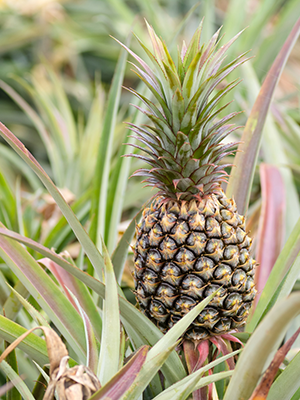
Smooth Cayenne: 5-6 lbs, pale yellow to yellow flesh. Large and conical, with green skin, this variety from Hawaii was once the only variety available in U.S. supermarkets. Leaves without spines. Cylindrical in shape and with high sugar and acid content, this variety is well adapted to canning and processing. Although it’s still it comprises 70% of world pineapple production, it’s now primarily used in canned pineapple.
Gold MD-2: 3-5 lbs. Sweeter and less acidic than Smooth Cayenne, this fat, round Hawaiian cultivar was developed in the 1970’s and now constitutes up to 75% of all fresh pineapples sold in Europe and more than 50% in the USA under names like Maui Gold, Yellow Gold, or Gold Extra Sweet.
Hilo: A compact 2-3 lb. Hawaiian variant of the Smooth Cayenne. The fruit is more cylindrical and produces many suckers but no slips.
Kona Sugarloaf: 5-6 lbs, white flesh with no woodiness in the center. Cylindrical in shape, it has a high sugar content but no acid. An incredibly delicious fruit.
Natal Queen: 2-3 lbs, golden yellow flesh, crisp texture and delicate mild flavor. Well adapted to fresh consumption. Keeps well after ripening. Leaves spiny.
Pernambuco (Eleuthera): 2-4 lbs with pale yellow to white flesh. Sweet, melting and excellent for eating fresh. Poorly adapted for shipping. Leaves spiny.
Red Spanish: 2-4 lbs, pale yellow flesh with pleasant aroma; squarish in shape. Well adapted for shipping as fresh fruit to distant markets. Leaves spiny.
Choosing and Storing Pineapples
Pineapples do not get sweeter after being picked. They will become slightly softer or juicier after a few days, but the sugar content does not change. Urban legends like turning a pineapple upside down for a few days do not redistribute the sugars. So the trick is to select a good one in the first place.
Look for fresh leaves and a sweet, fragrant aroma near the stem. Avoid pineapples that smell musty or sour, that have obvious dark spots or feel spongy to the touch.
In the United States, you can buy “Jet Fresh” pineapples from Hawaii, which tend to be harvested a riper stage than pineapples sent overland. Look for them during the peak Hawaiian season between March and June. Otherwise, you’ll most likely be buying pineapples from Costa Rica which peak in quality between December and February and August to September.
Start Your Own Pinerie
For a little aristocratic fun, create your own windowsill pinerie by replanting your pineapple crowns. Simply twist the crown to remove it from the fruit, and strip off some of the lower leaves, exposing about 1 inch of white stalk. Place the crown in a glass of water and place somewhere warm, like on top of the refrigerator. When the stalk has developed a healthy root system, about three weeks later, plant the crown in a small pot with well-draining, slightly acidic soil. Place in a sunny window where you can show off your new tropical pet with true Victorian pride.
